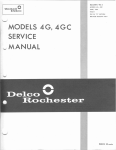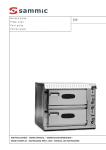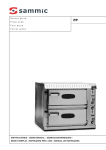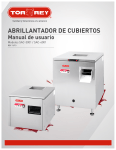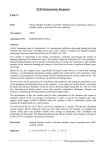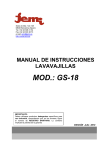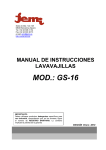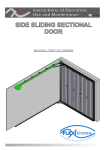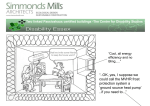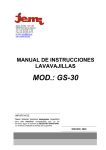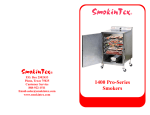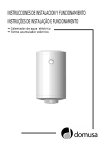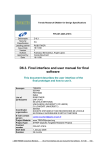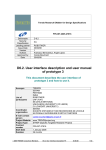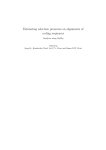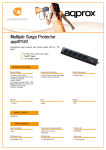Download Case Study
Transcript
FUSE Demonstrator Document PART I Title: Electronic washing program controller for industrial dishwashing machines. Microcontroller provides a flexible and cost effective solution. AE number: 29985 Associated TTN: ROBOTIKER (COTEC) Abstract: SAMMIC, S.A. manufactures different machinery for the food service industry including: potato peelers, mixers-beaters, vegetable processors, meat grinders, glassware-washing machines, dishwashing machines, vacuum-packed machines, etc. SAMMIC is a medium size Spanish company employing 130 persons, and achieved sales of 22,84 MEUR in 1.999. The company is specialised in the design, manufacture, marketing and through life support of machinery for the food service industry. The product improved during this AE is the company’s dishwashing machine supplied to catering business and communities such as hotels, restaurants, cafés and snack bars, through distributors and resellers of food service equipment. Before the AE, the company used electromechanical cam based programmers to control the operation sequence of the dishwasher. The company had no experience in electronics with no knowledge of microcontroller based system design. Thanks to the electronic technology SAMMIC can reduce the number of washing program controllers references used to control the wide range of dishwashers that the company produces. A more flexible and general control device has been obtained. The new washing program controller results in a more flexible solution with easier way to program and adjust washing cycles time. Additionally the electronic control system incorporates built-in fault diagnostics functions to make maintenance service even simpler. One of the main competitiveness factor of SAMMIC’s products is quality-price relationship. The new electronic washing program controller will allow the company to maintain their machines selling price and increase sales. Moreover, the company will extend the range of dishwasher’s models with the incorporation of new machines offering additional functions, like decalcifying function. The total cost of the AE was 37 KEUR and it was completed in 10,5 months. It is predicted that 240 additional units will be installed during the first year, and hence the payback period will be 1 year (15 months taking into account industrialisation costs). The company will achieve a ROI of 560% in relation to the project total investment. Keywords: Microcontroller, dishwashing machine, washing program controller, Signature: 2 – 0442 555 03 21 – 2 – 5530 – 2 – 29 - E -1- FUSE Application Experiment Nº 29985 1. Company name and address SAMMIC, S.A. Calle Atxubiaga, 11-14 E-20730 Azpeitia - Guipúzcoa SPAIN Phone: +34 943 157234 Fax: +34 943 812883 E-mail: [email protected] Contact Person: Mr. Juan Pedro Sesé 2. Company size SAMMIC, S.A. is a medium size Spanish company employing 130 persons, and achieved sales of 22,84 MEUR in 1.999. The estimation for sales in 2000 is of 25,24 MEUR. SAMMIC, S.A is part of the industrial group ENODIS. ENODIS is one of the most important manufacturers of food preparation equipment for industrial use in the international market, which turnover reach 900 MEUR last year. ENODIS catalogue includes a wide range of equipment or machines used at food service industry (restaurants, supermarkets, drink manufacturers and hotels). ENODIS group is integrated by several companies producing different kind of food preparation equipment, being SAMMIC the only one company of the group that produces additionally glasswashing and dishwashing machines. 3. Company business description Industrial Sector: Capital goods (machinery for the catering business). SAMMIC, S.A. manufactures different machinery for the food service industry including: potato peelers, mixers-beaters, vegetable processors, meat grinders, glassware-washing machines, dishwashing machines, vacuum-packed machines, etc. Its manufacturing facilities are located in Azpeitia, its mission being the manufacture and assembly of devices and machinery for the food service industry. SAMMIC’s entire production is distributed under “SAMMIC” brand to all domestic and international representatives, to be sold through distributors and resellers of food service equipment. The current company’s products catalogue includes a comprehensive range of different products classified in the following product classes: 1. Food preparation equipment: - Potato peelers. - Mixers-beaters. - Vegetable processors. - Meat grinders. 2. Hygiene and washing equipment: - Glassware-washing machines. - Dishwashing machines. -2- FUSE Application Experiment Nº 29985 3. Vacuum-packed equipment: - Vacuum-packed machines. Pictures in Figure1 show some of the different types of washing machines supplied by SAMMIC. The company has expertise in the design, production, assembly and sale of machinery for the catering business and communities: hotels, restaurants, cafés, snack bars, … Pass Through Dishwasher Front Loading Dishwasher Figure 1: SAMMIC’s Dishwashing Models. 4. Company markets and competitive position at the start of the AE The total market estimated for the machinery for food service industry and other technologies related to this sector is about 27.045,5 MEUR In the great diversity of products that constitute the “Food Equipment” business, all the products manufactured and sold by SAMMIC, S.A. fit perfectly. The “Food Equipment” market can be classified according to the product category into the following segments: l Vending l Glass refrigeration cabinets l Cooking l Refrigeration cupboards l Food serving equipment l Food preparation equipment l Hygiene and washing l Manufacturing of made-to-measure furniture l Warehousing l Ice production. The machinery manufactured by SAMMIC fits perfectly in the following segments: l Food preparation equipment: machinery such as potato peelers, mixers-beaters, vegetable processors and meat grinders. -3- FUSE Application Experiment Nº 29985 l Hygiene and washing: machinery such as glassware-washing machines and dishwashing machines. l Vacuum-packed: vacuum-packed machines. The following graphic points out the business distribution of production on relation to the products classes manufactured and distributed by SAMMIC. % Production 75,93% Food preparation 18,90% 5,18% Hygiene and washing Vacuumpacked Hygiene and washing Vacuum-packed Food preparation 80% 70% 60% 50% 40% 30% 20% 10% 0% Figure 2: Subdivision of company production. This second graphic points out the business distribution of sales on relation to products. %Sales 58% 60% 50% 27% 40% 15% 30% 20% Hygiene and washing Vacuumpacked Hygiene and washing Vacuum-packed Food preparation 10% 0% Food preparation Figure 3: Subdivision of company sales. This application experiment is focused in the development of an electronic programming device for the glassware-washing and dishwashing machines, for industrial use. The product line ranges from small glass-washing machines (2 Kw) to high-capacity machines (10,5 kW). Sales of this product are -4- FUSE Application Experiment Nº 29985 27% (4,8 MEUR per year, net) of total company sales, as it’s presented in Figure 3. The selling price of these machines goes from 600 EUR for economical models up to 2,2 KEUR for high capacity equipment. The glassware-washing and dishwashing machines are supplied to final users of establishments of catering business and communities such as hotels, restaurants, cafés and snack bars. Therefore, the industrial sector to which these products are oriented is the catering business. And the sale is made through distributors and resellers of food service equipment. Currently, the market is basically European and sales to Spain and England make up 72% of the total sales for the hygiene and washing equipment (glassware-washing and dish-washing machines). From now on, we refer to this equipment as dishwashers, in general. % Sales Others 11,5% Portugal 9,0% France 7,5% Spain 60,0% England 12,0% Figure 4: Hygiene and washing equipment sales distribution. Our strength as a company lies in the large expertise in the area of design and production of equipment used in food services sector together with control systems using electromechanical devices (cam-programmers). One of the main competitiveness factors of our products is quality-price relationship. On the market, SAMMIC’s products are considered to offer high quality compared with competitors, and less prices than them. Our most important competitors include in their products electronic control systems offering to the customers more functions than ours can. The strategy of the company is to maintain the prices and quality of our products improving our control system using electronics. This is the objective of the project and the new control system will allow the company to improve the competitive position, maintaining the current prices of our products. If we analyse the evolution of sales for our dishwashers we can see that, although the market for this equipment has shown a minor growth from 1996 till 1998, sales of our equipment had a significant increase last year. -5- FUSE Application Experiment Nº 29985 5.60 5.20 4.80 4.40 4.00 5.25 4.32 4.15 1996 4.54 1997 1998 Total Sales (MEUR) 1999 Figure 5: Sales evolution of glassware-washing and dishwashing machines. Therefore, we should maintain this evolution of the sales for the next years, maintaining the differences that make our products better than the ones from our competitors and including in our products those features that make our competitors better than we should. On the market, SAMMIC’s products are considered to offer high quality compared with competitors, although it’s to extend the catalogue including different types of washers as well as to offer new utilities for the control system than the electronic control device would offer. Among Spanish manufacturers the main competitors of SAMMIC are FAGOR Industrial and JEMI. These companies produce the same product range. FAGOR Industrial is an industrial cooperative belonging to the Mondragon group, which produces a great variety of products, including the washing line, that is our competition. Also in this product their production and sales are higher than ours (estimated in more than 10.000 units per year). JEMI is a company located in Barcelona, which has a collaboration agreement with the German company WINTERHALTER. Their production is very similar to SAMMIC, but they have a product line more completed, including large tunnel-type washing machines. In Europe, the main competitors are the Italian group ALI (Comenda, Honveed, Champion, …) and the HOBART group (Hobart, Elettobar, ...). There are also German manufacturers (Meiko and Wintherhalter) with a high-range of products of great quality at higher prices. These dishwashers’ manufacturers include electronic programming devices in all their products. In the following figure it’s presented the market situation in Spain of our main competitors. With respect to the international market, SAMMIC has only a 1% of the total sales of all competitors. % Internal market SAMMIC 13% Others 61% FAGOR Industrial 16% JEMI 10% -6- FUSE Application Experiment Nº 29985 Figure 6: Market Situation - Spain. The technical features of our products in comparison with our competition products in aspects as power, dimensions, production, etc. are similar. The difference is mainly the better finishes of the machines of our competitors. However, this better finish involves a greater cost, which can have an effect in the price of the machine; and in this kind of machines price is critical factor. Moreover, the range of products of our competitors is larger, including large tunnel-type washing machines with a power up to 30Kw. Main competitors use electronic control devices at their products. The competition has advantages and drawbacks compared with our product, those are: • • Advantages: • More reliable control systems. • Electronic diagnosis system to make service even simplier. • Automatic self-cleaning system (special cleaning programme). • Electronic dispensing system. • Electronic temperature control and display. Disadvantages: • Higher prices. We are producing good quality product at very competitive prices, but we need to improve reliability of the control device and improve some of its functional features. The adoption of the electronics technology will strengthen Company’s position in relation to competitors by: • Reliability and savings in maintenance. • Maintaining the current selling prices. • Including some additional features (diagnostics system, self-cleaning program, ..). 5. Product or process to be improved and the reasons to innovate The product to be improved by the development of an electronic programming device is a dishwashing machine for industrial use in establishments of catering business and communities such as hotels, restaurants, cafés and snack bars. The machine consists mainly of a water tank, a boiler and a pump. There are also control components such as electrovalves, thermostats, detergent dosing device, etc. -7- FUSE Application Experiment Nº 29985 Figure 7: Dishwashing Machine. The operation of the basic cycle is as follows: 1. Start-up: The water enters in the tank through the boiler by means of the operation of an electrovalve. A pressure sensor controls the level of filling of the tank. 2. Heating of water tank and boiler, according to inlet temperature: The heating resistances of the tank and boiler are activated once the water level is reached. The water temperature in the tank is between 55ºC and 65ºC and the temperature in the boiler is between 85ºC and 90ºC. The cycle consists of two phases: 3. Washing Phase: The washing pump sucks in the water from the tank working in a closed circuit and throwing the water through the washing diffusers. 4. Rinsing Phase: It operates by means of the water pressure from the net that goes to the boiler. The amount of water introduced in each cycle is approximately 3 litres with a temperature of 90ºC. During the cycle the detergent and polish are added to the water. The dishwashing machine has an overflow through which the spare water is drained by the gravity. In some models a pump is included to drain the spare water. The operation sequence is controlled through a cam programming device which actuates mechanical microswitches which in turn control the different components in the machine: washing pump, detergent dosing device, solenoid valves, etc. Currently, we are using 8 different references or types of cam-programmers designed for the different types of dishwashing machines produced by the company. Next figure shows some of these used cam-programmers. -8- FUSE Application Experiment Nº 29985 Wash Pump 6 5 Rinsing Electrovalve LEVA LEVA Fast Motor control Cycle 60” LEVA LEVA LEVA Slow Motor 180” LEVA 230 Vac 4 3 1 2 Fast motor control Cycle 120” Slow motor control Fast Motor 6” 230 Vac Drain Pump Figure 8: Currently used cam-programmers and basic block diagram of the current control system. The existing cam programming devices have the following limitations: l Maximum number of washing programs: 3 l Maximum number of outputs: 3 l Large response time in some cycles. l Less reliability than an electronic programmer. The cost of the cam-programmer depends on the controlled number of signals. The cost of a camprogrammer with 3 cycles and 2 signals is about 24 EUR. This type of cam-programmer is used for a range of dishwashing machines that incorporate some additional control devices (drain pump control, etc.). The total cost of all these electromechanical control devices is about 32 EUR. Assembly of such electromechanical control system requires hard wiring between cam-programmer and all the incorporated components. Next figure shows a general image of the existing control system. -9- FUSE Application Experiment Nº 29985 Figure 9: Control panel and control devices of a LV1200 Dishwashing Machine. The progress of the program of the dishwashing machine is controlled by the cam-programmer at fixed duration of each cycle of the program. The result is low flexibility and difficulties to tune the machine to special applications. The main reason to improve the existing product is to get a more reliable control device to overcome the limitations of the existing cam programming device and reduce the number of different types of controllers required to cover the wide range of dishwashing machines produced by the company. An important point is the cost of the control device, that must be similar or lees thant the existing one in order to maintain machine’s selling prices. Additionally we want to incorporate some technical improvements that are also required to get a competitive product compared with the competition. Here we include the main improvements we want to obtain with the new control element: • Reduction of the number of different types of control devices. Or objective is to replace the currently used 8 types of cam-programmers by 1 or2 models of electronic programming devices for all types of dishwashing machines. • Reduction of the wiring within the machine and greater compatibility among models, reducing the number of different spare parts. • Flexibility in the selection of cycle times. • Ability for the user to adjust some cycle parameters (rinsing time). • Possibility of adding new functions to the machine: control of metering soap or surfactant, controlling the water consumed in each cycle, drain cycles, automatic washing, etc. • Modern design of the product, more attractive to the user. • Improve machine control precision, reliability and duration of the control’s components. • Include control testing and fault tracing facilities for product maintenance operations. - 10 - FUSE Application Experiment Nº 29985 6. Description of the product or process improvements The new developed control board incorporates a PIC 8-bit microcontroller as central component. Such electronic programmer allows up to 22 input/output connections. Next figures show the electronic prototype developed during this AE. Figure 10: Electronic programmer for dishwashing machine. The basic input/output signals are the following ones: Input Signals: • • 4 digital input signals at 230 Vac.: • Tank filling detector (pressure sensor): Normally open contact indicating water level at the washing tank. • Boiler’s thermostat: Normally closed contact. This input signal indicates if the selected water temperature has been achieved at the boiler. • Tank’s thermostat: Normally closed contact. This input signal indicates if the selected water temperature has been achieved at the washing tank. • Door open/close detector. Control panel’s selectors or push-buttons: • Program selection push-button • Start/Stop push-button • Emptying push-button • Rinsing time selector. (Analog input) • Flow-rate meter: Some dishwashing machines use a flow-rate sensor to detect the water supplied to the washing tank during rinsing phase. The water flow is proportional to the number of pulses generated by the flow meter sensor. • Configuration switch: The new control board includes a 4-digit switch to select the model or type of dishwashing machine. Output Signals: • 7 triac based output signals to operate the following machine components: • Washing pump. • Draining pump. - 11 - FUSE Application Experiment Nº 29985 • • Detergent dosing device • Pressure pump. • Boiler’s heating resistance contactor. • Tank’s heating resistance contactor. Control panel’s leds: • program selection. • “Machine Ready”. Next figure shows the block diagram of the developed electronic programmer. DOOR PRESOSTAT T. TANK T. BOILER DIGITAL INPUTS TLP 504A I S O DIGITAL OUTPUTS TLP 3023+TRIAC L A T I O N 4 POWER 230 Vac 5V 50mA WASHING PUMP HOT WATER TANK EV-AF DRAIN PUMP BOILER EVA 7 CPU PIC 16C72A I S O L A T I O N8 1 4 4 8 FRONT PANEL ANALOG INPUT Rinsing Time SEL. I/O EMP. RINS. SWITCH type Selec. LEDS Status Figure 11: Hardware architecture One of the most important aspects considered during the design of the new washing program controller has been the final cost of the product. In this way, the introduction of any component has been carefully studied. One of the decisions was not to include an external non-volatile memory module to store washing program progress. The dishwasher machine has no problems to restart the washing program from the beginning if any power supply failure occurs, no special restarting procedure is required. So is not necessary to store the washing program progress and in this way the external memory is not required. The electronic programmer can be adapted to different types of dishwashing machine. This prototype will be included in some of the more complete company’s dishwashers. The selection of the machine model is done through a set of configuration switches. In this way the same control board can be - 12 - FUSE Application Experiment Nº 29985 used for range of our products. Depending on the selected code the electronic programmer uses different cycle parameters (washing cycles and cycle times) and actuates additional functionality like: • pressure pump and draining pump. • decalcifyer. • water change in each cycle. A special configuration code has been included that allows testing of the electronic programmer operation and system fault detection. In this way, the maintenance and fault detection of such system is easier and faster than that using the electromechanical cam-programmer. Thanks to the programmability of the electronic controller, machine’s cycle parameters can be easily modified and adjusted during control installation without any mechanical modification. The main improvements achieved by this new solution are: • Reduction in the number of references for the currently cam-programmers (electromechanical devices). A single type of electronic programmer replaces to 4 types of cam-programmers. • Flexibility in the variation of cycle times, only software modification is required. This result faster, easier and cheaper than the modification of the cam-programmer in the existing products. • Easy and fast adaptation of the control system to each machine type by selecting the corresponding code through a set of configuration switches. • Reduction of assembly time by having multiple-pin connectors and eliminating discrete electromechanical components such as indicator lamps, pushbuttonns, etc. A 25% reduction of the required assembling time is expected. • Ability for the user to adjust some cycle parameters (rinsing time). • Incorporation of testing and fault detection facilities for maintenance operations. • The reliability and duration of the electronic components is higher than those obtained using mechanical moving parts (no mechanical wear). • Modern design of the product, more attractive to the user. • The final cost of the electronic programmer is about 30 EUR, similar to the cost of the existing electromechanical control components (cam-programmer + drain pump control 32 EUR) 7. Choices and rationale for the technologies, tools and methodologies The selection of the technology for the electronic washing program controller for SAMMIC’s Dishwashing machines was conducted using the following criteria: 1. Flexibility and ability to change controller programme in order to facilitate additional product features in the future and adaptation of the electronic programmer to the different types of dishwashing machines. 2. Cost-effective for volume productions <2000 units per year. 3. Total cost of the new control device < 32 EUR per unit. 4. Assure the achievement of the necessary functional improvements. - 13 - FUSE Application Experiment Nº 29985 5. Assure high fidelity functioning and easy maintenance. 6. Reliability within the potential hard environment of high temperatures and humidity. 50ºC with steam presence. The alternatives considered are: • ASIC: The estimated volume production can’t justify the application of this technology. Flexibility and ability to change the controller program and program parameters was also very important. An ASIC solution can not be adapted as easily as a microcontroller. Moreover, the development costs and prototype costs were very high. • FPGA: This technology is more flexible and can be modified more easily than ASICs, but the development costs were also high and the engineering work necessary to create a revised FPGA component was more complex and costly. • Discrete components: This solution would have lower cost but it was not very flexible and changes in parameters would require physical replacement of components. So this technology was not suitable for this application. • Microcontroller: It was decided therefore that an in-circuit microcontroller based system would provide the lowest cost, more flexible and adaptable system, with assumable development costs and shorter lead-time to introduce the product in the market. Several microcontrollers have been evaluated during the selection process, taking into account the following application requirements: • Low cost component is required. • Maximum of 22 input/output signals • It’s not necessary to store large amount of data • Non-volatile memory is not required • No high precision analogue measurements are required. • Operating conditions: 50ºC The microcontroller selected was finally a PIC 16 C72 I from Microchip Technology because it gives all the required functions in a single chip. The new control system includes an industrial version of this PIC microcontroller which operates at high temperatures. The main features of this selected microcontroller are: • 4K x 14 EPROM program memory • 176 bytes of general purpose RAM memory • 22 bi-directional I/O lines • Analogue comparator module with two precision comparators • 8 bit timer/counter • Extended voltage range (2,5 to 6,25 V) - 14 - FUSE Application Experiment Nº 29985 • Operating temperature: - 40 ºC to +85ºC The designed board includes a specific configuration code (configuration switches) to test board operation. In this way it’s possible to diagnose any fault arising in the electronic programming device. This point is important for maintenance service of the product, as well as for personnel training on the new electronic programming device. The fabrication technology has been the traditional PCB. The design includes encapsulation of the components in an epoxy resin for protection against moisture. Design of the PCB was performed using “Tango” program that runs on a conventional PC. The software development for the microcontroller was done with an emulator supplied by the manufacturer. The project was implemented using assembly language on tools owned by the subcontractor. 8. Expertise and experience in microelectronics of the company and the staff allocated to the project SAMMIC is a company specialising in the design, manufacture, marketing and through life support of machinery for the food service industry. Before the AE the company didn’t have any electronics specification and design capabilities. The existing product used a mechanical cam controller and didn’t include electronics. The main expertise of our technical staff was related with mechanical and electromechanical applications. Their activities were mainly concerned with electrical installation and final tests of the old control system. SAMMIC didn’t possess any electronic design CAD tools, not microprocessor development tools. The company had no experience in the area of microcontroller technology. SAMMIC was therefore a first user of this technology. Company staff allocated for to the application experiment: The project team involved in the AE is as follows: Product Engineering Manager (Washing Equipment) 12 years experience Prototypes Assembling Technician 24 years experience Person in charge of Electric Design 2 years experience 9. Workplan and rationale The different tasks carried out during the project are detailed below, showing both planned and real effort and costs involved: 1- Management: The company assumed the responsibility of project management task. The product manager of the company elaborated the initial project plan, generated a monthly progress report and final dissemination information. The roles of the subcontractor was to assist with - 15 - FUSE Application Experiment Nº 29985 electronics project management experience and generate the final user or technical documentation. Duration Planned Real 10,5 months 10,5 months FU Labour (man-days) 5 9 FU Cost (kEUR) 1,7 2,3 Subcont. Cost (kEUR) 1,7 1,7 2- Analysis and Specification: The specification phase has been conducted by the company. A deep analysis of the functional requirements of the hole range of dishwashing machines has been carried out in order to get a more general solution. An intensive work has been done during this specification task. During this phase the detailed specifications of the new electronic programmer were generated, including: Functional requirements of new control system (both hardware and software), required input/output interfaces, definition of environmental and operating conditions and norms; and prototype testing methodology. Duration Planned Real 6 weeks 9 weeks FU Labour (man-days) 10 25 FU Cost (kEUR) 3,4 4,45 Subcont. Cost (kEUR) 1,7 1,7 3- Training: An initial training course on project planning and microcontroller based products specification was provided by the subcontractor to the company’s product manager. During the project other additional training courses on software design and testing technologies were provided to the company’s technicians working in the project. At the end of the project a 2 day training action was provided by the subcontractor in order to resume all the work developed during the project. Duration Planned Real 10,5 months 10,5 months FU Labour (man-days) 16 26 FU Cost (kEUR) 3,8 4 Subcont. Cost (kEUR) 3 3 4- Design: During this phase prototype’s hardware and software has been designed and developed. Two prototype development steps have been done. This phase has been handled mainly by the subcontractor with participation of the company to understand hardware architecture design and software module definition. The subcontractor conduct electronic design, PCB layout specification and microcontroller code development. Duration Planned Real 3,5 months 3,5 months FU Labour (man-days) 16 22 - 16 - FU Cost (kEUR) 5,4 3,2 Subcont. Cost (kEUR) 7 7 FUSE Application Experiment Nº 29985 5- Evaluation: During this phase the following testing work was performed: • • • Hardware and software integration and initial functional testing of the first prototype. The results of these tests were used to develop the final prototype. The company’s technicians conducted the functional testing of the final prototype. Integration of the final prototype with the machine and final testing were conducted by the company’s technicians assisted by the subcontractor Evaluation task has required more time and effort than that initially planned because: • • Additional tests, not initially planned, in order to test the selected microcontroller working at hard temperature and humidity conditions. A basic board was developed at the begining of the first prototype design phase including only few components (microcontroller, capacitors, ..). This board was incorporated to a dishwasher and intensive tests performed at high temperatures. Final tests of the second prototype required more effort than that initially planned in order to obtain a prototype that should be presented at the sector exhibition. FU Labour (man-days) 10 35 Duration Planned Real 2,5 months 2,5 months FU Cost (kEUR) 3,4 4,9 Subcont. Cost (kEUR) 3,4 3,4 The following Gantt chart includes the planned and real duration of the different tasks of the project: Activities Month 1 2 3 WP 1-Management 1.1- Project Management 1.2. Final documentation X X X X WP 2- Specification 2.1 Functional specification 2.2 Test planning definition X X X X WP 3- Training 3.1 Management training. 3.2 Specification Training 3.3 Design training 3.4 Evaluation training WP 4- Design 4.1 Electronic and soft Design 4.2 Design review 1 4.3 PCB electric plan & firmw. 4.4 First prototype production 4.5 Design review 2 4.6 Production 2nd prototype WP 5- Evaluation 5.1 1st functional testing 5.2 2nd functional testing 5.3 Final tests X 4 X X 5 X X 6 X X 7 X X 8 X X 9 X X 10 X X 11 X X X X X X X X X X X X X X X X X X X X X X X X X X X - 17 - X X X X FUSE Application Experiment Nº 29985 Planned X Real Next table summarises AE effort and costs: Task Management Specification Training Design Evaluation Duration Planned Real Planned Real Planned Real Planned Real Planned Real 10,5 months 10,5 months 6 weeks 9 weeks 10,5 months 10,5 months 3,5 months 3,5 months 2,5 months 2,5 months FU Labour (man-days) 5 9 10 25 16 26 16 22 10 35 FU Cost (kEUR) 1,7 2,3 3,4 4,45 3,8 4 5,4 3,2 3,4 4,9 Subcont. Cost (kEUR) 1,7 1,7 1,7 1,7 3 3 7 7 3,4 3,4 10. Subcontractor information The main support for the Application Experiment came from SEDEP. This subcontractor was selected for the following reasons: • Prior experience of developing control systems using microntroller technologies. • The ability and agreement in the objective of transferring knowledge. • Vicinity to the FU. The subcontractor provided both management and technical expertise for the project and training actions. The subcontractor was responsible for the design of the microelectronic components of this AE and they provided: • Checking on the initial SAMMIC functional specifications. • Detailed system and technical specifications. • Hardware and software architecture design. • Microelectronic system and circuit design. • PCB circuit details and layout for manufacture. • System documentation: circuit diagrams, design notes, software listings and disk containing source and compiled code. The subcontractor provided a fixed cost quote for the project, including engineering activities, training activities and provision of one prototype. The fixed cost basis for performing the work by the subcontractor assured the company that this element of the project would stay within the planned budget. Payments were made on a phased basis according to agreed deliverables with a final payment after tests on prototype were finished. First user and subcontractor agreed on a contract with clear responsibilities of both parts. - 18 - FUSE Application Experiment Nº 29985 - 19 - FUSE Application Experiment Nº 29985 PART II 11. Barriers The company has large experience and facilities in electromechanical engineering and electromechanical control devices for washing machines. The company has the clear intention to improve their existing products to improve competitive position. The company also realised that electronics technology would be a good solution for their products but we didn’t have any previous experience with this technology and it was not clear how to approach the right solution. As FU of electronics technology we faced several barriers before the AE started: • Psychological Barriers: As many companies with no previous experience in microelectronics, SAMMIC believed that adopting such new technology was risky. The company has the clear intention to improve their existing products to improve competitive position. Due to our large expertise in cam-programming devices our main efforts were focused in mechanical improvements of the existing systems. • Knowledge and Technical barriers: • Improvements that microcontroller technology will add to existing products • How to manage such new technology development project • Economic implications of adopting this new technology • How to interface to subcontractors • How to select the most suitable solution • Financial barriers: A further consideration was the level of financial investment required to undertake the development of a new electronic programmer and the final cost that such new control system would have. Any investment in research, development and industrialisation of a new control system can affect production and sales. Such investment could not be undertaken without a high degree of confidence in the final technical solution and in the company’s ability to acquire the technical knowledge it requires to maintain the system and support it. • Resources barriers: Another important problem for the company was that we couldn’t spend much time in new developments. 12. Steps taken to overcome the barriers and arrive at an improved product or process • Psychological barriers: The process of overcoming the barriers listed in section 11, specially the knowledge barriers and some of the financial barriers started following an initial contact with the TTN. During this first step the company was assisted by the TTN in the analysis of the following topics: • The available technologies and their merits. • Initial selection of the most suitable technical solution. • Analysis of the main technical benefits of a new development. - 20 - FUSE Application Experiment Nº 29985 • Initial estimation of the final cost of a new control device. This initial analysis resulted in the selection of microcontroller technology and covered both technical and economic aspects of adopting this technology. The next step of the process was the preparation of the FUSE proposal. • Knowledge and technical barriers: To overcome technical barriers we used the expertise of the TTN and the subcontractor. Both TTN and subcontractor supported our activity in different phases during the AE: • In a first phase the TTN followed the proposal documents preparation that allowed the company to overcome more of the knowledge barriers and allowed us to generate a detailed project plan. • In a second phase our technicians received technical training, which provided them the capacity to specify and control microcontroller based development. The company’s technicians participating in the project have been trained on general electronics technologies and more specifically on electronics testing methods. They will be responsible of the new product maintenance and support tasks in the company. During this phase two different ways of training have been used: • Dedicated training actions prior to start the different tasks of the project and a final training task when the project was finished. • “On the job” training during the project development. At the end of the AE development an additional training was carried out to the company’s personnel working in the project, including a revision of the different tasks developed during the project. The selection of an experienced local company as subcontractor that has large expertise in electronic design and development, have ensured a continuous transfer of the different technical and management expertise necessary for the use of the new technology. • Economic barriers: Agreeing a fixed price contract for hardware and software development with the subcontractor has controlled cost and risk. 13. Knowledge and experience acquired The company has acquired knowledge in the following specific topics: • Electronics development project management: Definition of the different phases involved in an electronic product development project, planning of these phases and progress control. • Product Specification: Detailed analysis of some of the main components of the system, potential of microcontroller based developments, interfacing definition, and product specification methods. • Hardware design: Understanding basic electronics design. • Specification methods for PCB production and assembling. • Tests planning methods and fault detection methods. • Integration of the electronics control device with the company’s machine. Electronics testing development. - 21 - FUSE Application Experiment Nº 29985 • User documentation methods for electronic based products. User manual and installation manual generation. The company has obtained the initially planned knowledge. The company didn’t want to become electronics designer of developer. Our objective was to have the necessary control and knowledge to: • Maintain the electronic programming devices that we include in our machines. • Specify new improvements for the control system which development can be subcontracted to other companies. Minor changes of microcontroller software, like parameter value modification, are intended to be done by the company. More important software modifications and any hardware modification should be subcontracted also in the future. The new controller has been designed in a way that SAMMIC will be able to select different wash programs and cycle times using a set of configuration switches incorporated in the board. Up to 15 different configurations have been included and preprogrammed, giving the company sufficient options to adapt the product to specific dishwashing machine. 14. Lessons learned The important lessons learned by the company during this application experiment are the following: 1. Creating FUSE proposal and Technical Annex involved the realisation of a technical study into the improvement that electronics would bring to our product and the preparation of a detailed workplan. We consider that the support of the TTN and the selected subcontractor during this phase had been very efficient and have allowed the company to overcome some of the company’s initial knowledge barriers. 2. An important task of the project was detailed specification generation. During this phase an intensive analysis of the functional requirements of the wide range of dishwashing machines was performed. This was an important task that gave us a complete vision of the new product requirements including technical and price requirements. The final cost of the electronic washing program controller was specially considered to decide which functions and signals would be included in the prototype. In this sense we decided: • Not to include continuous temperature sensors and temperature display. Thermostats will be included and connected to the washing program controller through digital signals. This feature will be included in future developments. • No time display will be added in this cycle-controller version. 3. The company has learnt about the advantages and possibilities of the electronics over electromechanical control methods. The results of the project have demonstrated a good selection of the technology. Microcontroller technology allowed the company to implement all the required improvements and get a flexible electronic washing program control system at a reasonable cost. 4. This AE was the first experience of the company with electronics technology. We have learnt that microcontroller technology brings important benefits to our products. We consider that we have obtained the necessary experience and knowledge to specify and manage future improvements or modifications of the developed control device. We will need third party assistance to develop new hardware developments, and PCB production and assembly, but we - 22 - FUSE Application Experiment Nº 29985 will be able to control and manage these new projects. The company didn’t want to become electronics designer or developer, future projects will be subcontracted, but we wanted to verify the potential of this new technology and learn how to manage a project in this new area. 5. Software development tools required during the project were those owned by the subcontractor. We have learnt that it should be useful for us to have these software development tools at the company in order to have capacity for minor future changes to modify washing program parameters. Taking into account the results of the project and the low prices of such development tools for the used microcontroller, our intention is to install these tools at our facilities not to depend on a subcontractor for such minor changes. 6. The final prototype developed in the project has been produced and mounted by a local electronics supplier. We have got the necessary experience to control and manage these activities. - 23 - FUSE Application Experiment Nº 29985 PART III 15. Resulting product or process, its industrialisation and internal replication. The project was completed and the developed electronic washing program controller worked successfully. The prototype developed during this project has been incorporated to a SP500 XP dishwasher that has been presented at a sector exhibition (HOSTELCO 20 - 25 October) in Barcelona. Figure 12: New SP500 XP Dishwashing Machine. The developed new product is a flexible, cost effective and reliable solution that overcomes the problems and limitations of the control device used by the company up to now. The prototype obtained from the AE is near to be an industrial product. But due to the hard environmental operating conditions (high temperatures and high humidity) an additional effort and work is required to industrialise the developed washing program controller. The following main tasks are required during this industrialisation phase: 1. Intensive laboratory life-tests of one prototype in order to validate the final design (circuit protection and components operation). • Test duration: 3 months • Prototype working 20 hours per day. 1200 hours of machine work. 2. Real operation tests: Installation of 2 prototypes at customers facilities in order to test the prototype working in real conditions with periodic revisions. The estimated duration of this task is 3 months at least. - 24 - FUSE Application Experiment Nº 29985 So a 6 months industrialisation phase is considered with an estimated cost of 20 KEUR. During these industrialisation activities the company will receive the support of the subcontractor and will maintain access to subcontractor’s facilities. Related with the production and assembly of the circuits included in the new control device, the company will subcontract these tasks to the PCB assembly company that has produce the final prototype generated in the AE. The inclusion in the company’s products catalogue will be made firstly in the more complete and expensive models of the product line: l Pass through dishwashers, equipped with a pressure pump: model SC1200XP. l Front loading dishwashers: model SP800XP Afterwards, the following models are foreseen to be included: l Dishwasher equipped with a decalcifyer. l Dishwasher equipped with water change in every cycle. l Economic model to be included in the cheapest dishwashing machines: model 12 E/S. Regarding the economic model, which is the one to be included in the low range of dishwashing machines (that is, the cheapest ones), we have considered to develop a simpler control board with only 12 signals. This fact has already been considered in the design carried out within this project. In this way, we can get a cheaper control board for those dishwashing machines that are simpler. Finally, it must be mentioned that SAMMIC has also foreseen the manufacture of tunnel-type dishwashing machines of more power. This kind of machines is already manufactured by our competitors. We will also include the new electronic programmer in these machines in order to have a competitive advantage over our competitors. 16. Economic impact and improvement in competitive position. The final cost of the electronic programmer is about 30 EUR, similar to the cost of the existing electromechanical control components (cam-programmer + drain pump control 32 EUR). Additional saving results from the reduction of the time required during control assembling and adjusting operations. We estimate that the global cost reduction per unit will be about 15 – 20 EUR. Availability of the new control system enables us to produce a more reliable and improved dishwashers maintaining our products selling price. Incorporation of the new electronic washing program control device will produce an increase of sales and additional profit for the company. As we indicated in previous chapter, our first step will be to incorporate the new washing program control device in the more complete models, like SC1200XP and SP800XP. These new models will replace some of the current existing models and a third not existing machine will be included SP500D that incorporates a decalcifying device. The projected sales for such new dishwashing machine’s will be about 240 units during 2001 and 640 during 2002. During 2001 the new control system will replace the old system in a small part of the existing models, the incorporation to the existing models will be done in a progressive way. Next char shows the estimated increase of sales, in number of units, for the next three years. - 25 - FUSE Application Experiment Nº 29985 6.000 1.200,0 5.000 1.000,0 4.000 800,0 3.000 600,0 2.000 400,0 1.000 200,0 0,0 0 2000 2001 2002 2003 Units Old Units new Benefits with new system (KEUR) Figure 14: Additional projected sales (in units) for dishwashers and glasswashers.. These additional projected sales will allow the company to increase its profit in 2001 by 37,6 KEUR, and 80 KEUR during 2002. So the pay-back time of the project can be estimated in 12 months ( 15 months if we take into account industrialisation costs). The AE total costs, including industrialisation of the new product, are around 57 KEUR. The expected life of the improved product developed during the AE is 5 years. With the projected company’s profitability resulting from introducing the new control device in their products, the company will achieve a ROI of 560% in relation to the project total investment. 1.200,0 1.100,0 1.000,0 900,0 800,0 700,0 600,0 500,0 400,0 300,0 200,0 100,0 0,0 Benefits without new system (KEUR) Benefits with new system (KEUR) Difference Cumulative AE+Indus AE cost 2000 2001 2002 - 26 - 2003 FUSE Application Experiment Nº 29985 Figure15: Additional projected profit (KEUR) for different models of dishwashers. 17. Added value to the portfolio and target audienceIn general this application experiment demonstrates the benefits of the application of microelectronics technology to a range of companies that have no experience of microelectronics. Companies currently using electromechanical cycle programmers for machine control can be motivated to replace such systems by electronics based control devices. Dissemination of the results of this AE will be interesting for all those companies producing machines that include electromechanical programming devices, which could be replaced by electronic ones. Clear examples of this kind of companies are manufacturers of laundry washing machines and other manufacturers of dishwashers, independently of the industrial or domestic use of these machines. SAMMIC’s experience during this application experiment will be of particular interest to the following categories of company: a) Small and medium companies involved in machinery construction and using electromechanical control techniques b) Companies involved in electromechanical applications with no previous experience in electronics. c) Companies with the same size, not necessarily in the dishwashing machine segment but in other Food Equipment segment, lagging behind the current state-of-the-art in electronics. The lessons learned could be useful for them, while convincing them to invest in microcontroller based innovation. This AE demonstrates that acquiring the knowledge and skills required to control, understand and maintain a new microprocessor based control device can be achieved from a modest starting point and with limited human resources. The company will further subcontract hardware development and production in the future, but we will be able to control these new developments. This strategy is a reasonable technology step for a first user company. Best practice summary: 1. TTN involvement in planning and feasibility study. Such specialised support is highly recommended to microelectronics first users companies. 2. Technology options analysis and competitors study identifying the needs of the customers. 3. Subcontractor with experience in the application area. The acquisition and development of a novel technology must be accomplished with external help. 4. Knowledge acquisition on basic electronics, requirements specification, testing and user documentation methods for electronic based products has been part of this AE. Detailed electronic design and software development was not considered because this activity will be subcontracted in future projects. 5. Managerial role of the FU. The management of the project by the FU has been a great help to know the peculiarities of electronic development projects, useful for future internal replication of the experiment to other products. - 27 - FUSE Application Experiment Nº 29985



























